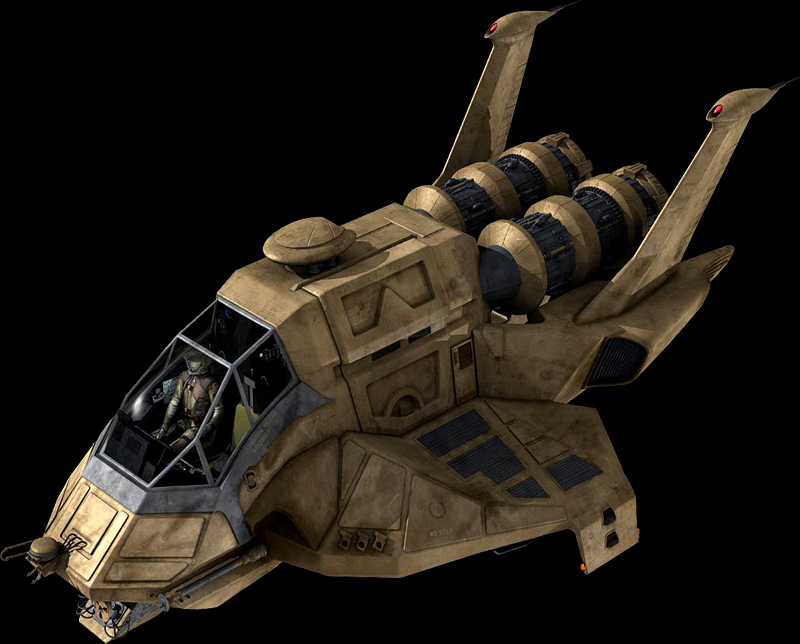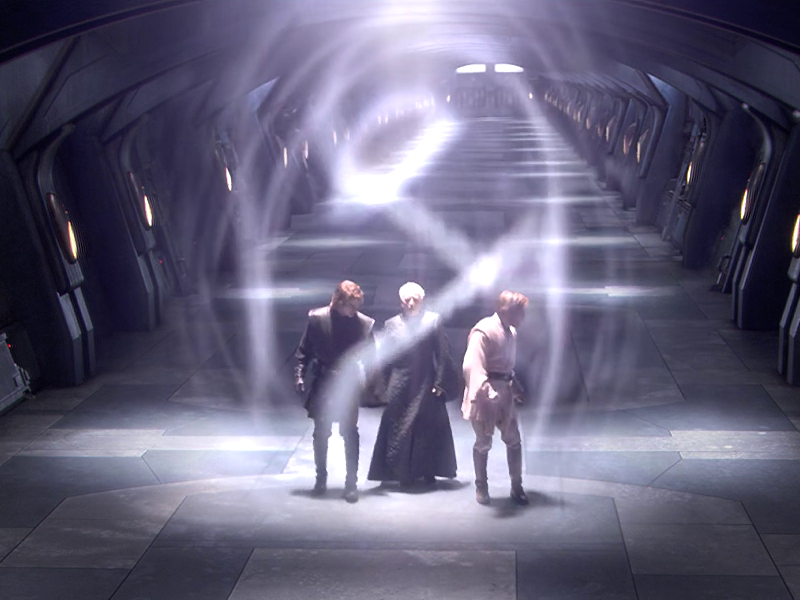 RAPTOR
Craft: Colonial Raptor
Type: Multi-purpose support vehicle
Scale: Starfighter
Dimensions:
-Length: 8.6m (28ft)
-Height: 2.9m (9.5ft)
-Wingspan: 5.6m (18.34ft)
-Weight: 50 tons
Skill: Space transports; Raptor
Crew: 1 (pilot); 2 (pilot and ECO or co-pilot); or 3 (pilot, co-pilot and ECO)
Crew Skill: Astrogation 4D, computer programming 4D, sensors 5D, space transports 3D+2, starship gunnery 2D+2
Passengers: 5 to 10
Cargo Capacity: 1 metric ton (with no passengers), or 100 kilograms (with max passengers)
Consumables: 2 weeks (emergency packs, crew only)
Cost: 125,000 Colonial credits
FTL Capable: Yes
Nav Computer: Yes
Maneuverability: 3D
Speed:
-Space: 8
-Atmosphere: 365; 1,050kmh
Hull: 5D
Defenses:
-Shields: N/A
-ECM: +2D (see below)
Sensors:
Passive: 40/1D
Scan: 80/2D
Search: 160/3D
Focus: 5/5D
WEAPONS (OPTIONAL):
8 Weapons Hardpoints
-Nuclear Missiles
-Bombs
-Anti-Walker Munitions Pods
-Anti-Speeder Munitions Pods
-Missile Quad Racks
-Cannons
Location: Mounted on various hardpoints on the hull (see below)
Fire Arc: Front (All)
Crew: 1 (pilot, co-pilot or ECO)
Skill: Starship gunnery
Scale:
-Nuclear Missiles: Capital
-Bombs: Starfighter
-Anti-Walker Munitions Pods: Walker
-Anti-Speeder Munitions Pods: Speeder
-Missile Quad Racks: Starfighter
-Cannons: Character
Fire Control: 3D (All)
Space Range:
-Nuclear Missiles: 1/3/7
-Bombs: N/A
-Anti-Walker Munitions Pods: 1/3/6
-Anti-Speeder Munitions Pods: 1-2/8/16
-Missile Quad Racks: 1/3/7
-Cannons:
Atmosphere Range:
-Nuclear Missiles: 100/300/700m
-Bombs: N/A
-Anti-Walker Munitions Pods: 30-100/300/600m
-Anti-Speeder Munitions Pods: 20-200/800/1.6km
-Missile Quad Racks: 50-100/300/700m
-Cannons: 6-12/75/150m
Damage:
-Nuclear Missiles: 10D (Blast Radius: 10D/9D/8D/7D)
-Bombs: 8D (Blast Radius: 8D/7D/6D/5D)
-Anti-Walker Munitions Pods: 8D
-Anti-Speeder Munitions Pods: 7D
-Missile Quad Racks: 8D
-Cannons: 7D (Blast Radius: 7D/6D)
Ammo:
-Nuclear Missiles: 1 per hardpoint; up to 8 total
*Nuclear Assault Pods: 12 per pod; up to 24 total (2 pods, see below)
-Bombs: 4 per hardpoint; up to 16 total
-Anti-Walker Munitions Pods: 30 rockets per pod; up to 120 total (average 2 pods)
-Anti-Speeder Munitions Pods: 200 rounds; up to 800 total (average 2 pods)
-Missile Quad Racks: 4 missiles per rack/hardpoint; 16 total
-Cannons: 50 rounds; up to 200 total (average 1 or 2 cannons)
Rate of Fire:
-Nuclear Missiles: 1 to max ammo; Missile volley; Missile barrage
*Nuclear Assault Pods: 1 to max ammo; Missile volley; Missile barrage
-Bombs: 1 to max ammo; Bombing run; Saturation bombing
-Anti-Walker Munitions Pods: 1 to max ammo; Autofire
-Anti-Speeder Munitions Pods: 1 to 3; Autofire
-Missile Quad Racks: 1 to max ammo; Missile Volley
-Cannons: 1
SPECIAL: Where Autofire is listed, see D6 Firearms in the Supplements section for rules and details. Where missile volley, missile barrage, bombing run and saturation bombing are listed, see D6 Missiles in the Supplements section for these rules and how it affects these weapons. These are alternate rules that enhance the capabilities of these weapons, but are NOT necessary to use the write-up.
DESCRIPTION:
The Raptor is a vehicle utilized by the Colonial military. While it is designed to perform multiple roles, the Raptor most commonly takes part in reconnaissance and scouting operations.
------------------------------
-GAME NOTES-
Sensors: The sensors on the Raptor are comparable to those used on capital vessels. While the Raptor is starfighter scale, it is meant for extensive recon roles involving a powerful sensor suite that would need to be more advanced than those of a fighter. As such, they have greater range, as well as being able to collect more varieties of data (life signs, energy signatures, gravitational readings, elemental compositions such as gases, metals, water, etc.), while also having a greater ability to process all of this data. These systems go hand-in-hand with it's ECM package, and if one is disabled, the other is also inoperable. The sensors can be used by both the ECO and the pilot or co-pilot. For more specific uses, see below.
Electronic Countermeasures (ECM): The Raptor's ECM package allows it to perform electronic warfare roles in combat that can hinder the enemy and, at the same time, give it and its allies the advantage in the theater of battle. As listed above, this is a part of the sensor systems carried by the Raptor, and if the sensors are rendered inoperable, then the ECM will also be out of commision. The ECM grants a +2D for ECM actions. When performing an ECM action, the ECO chooses a fire-arc to affect, and the +2D is added to the sensor dice based on the sensor range the targets are in (ECO's skill dice + 2D + 1D at Passive, 2D at Scan, 3D at Search, or 5D at Focus). It can be used against one target or several, affecting them all (though the GM must figure out how to work out the different dice and ranges). Multiple fire arcs can be affected, at -1D per extra arc, for a maximum of -3D if affecting all four fire arcs.
The ECO must make a Sensors skill roll when using the ECM. It can effectively jam sensors and communications (by wireless or relay such as laser line-of-site, etc), and can also jam guided weapons systems, and can even clear enemy jamming signals to keep allies free from being affected in the same manner; each of these takes a separate ECM roll with the Sensors skill. ECM actions to jam enemy sensors and communications simply have to roll higher than the target's skill rolls in these. When using ECM against guided weapons, it depends on the kind of weapon: if the weapon is manually used by a person but has some kind of fire control, then the ECM negates fire control dice equal to the range the target is at in the Raptor's sensors (-1D at Passive, -2D at Scan, -3D at Search and -5D at Focus), and the manual operator still gets their skill dice for the attack, with a penalty to their fire control (the ECO simply has to roll against Difficult Difficulty); if the weapon is automated and NOT manually operated, or of capital scale (most are 'usually' not manually operated), then the ECO simply has to make a roll against the target's skill roll and beat it to make the weapon unable to target anything.
To clear enemy jamming, the Raptor must roll against the enemy's ECM roll and beat the roll. In effect, if two opposing ECM systems are being used in a battle, the tide could shift repeatedly as they both continuously fight for electronic dominance in combat, and allies and enemies would be blessed or cursed each round as one or the other gained control. For this reason, group tactics with Vipers and Raptors usually plan ahead to take out enemy ECM craft to gain this advantage for themselves in any fight they find themselves in.
Drones/Equipment: The Raptor is equipped with several kinds of drones and other equipment for various purposes, all used by the pilot or co-pilot, and are as follows:
-6 Decoy Drones: When launched, these drone can fly at the Raptor's Speed in any desired direction, giving off all the appropriate energy signatures to be identified as another Raptor, intended as a way to lead enemy targets away from the real Raptor or trick them to fall for traps and other tactics. Decoy drones require a Very Difficult Difficulty Sensors roll to determine they are fake. The drone has a Dodge/Maneuverability of 5D.
-4 Communications Drones: These drones can enhance the Raptor's communications ability and range, granting a +2D to cut through enemy jamming when launched, which lasts for 1D+2 rounds. If needed, the drones can carry recorded data in any form (such as visual, audio and any kind of relevant sensor information) and be launched with this information to be found later by the Raptor's fellow base ship or other support craft such as Vipers or other raptors. The drone has a Speed of 8 and a Dodge/Maneuverability of 5D.
-4 Sets of Flares: These can be used for various purposes, from signaling for emergencies to luring away or misguiding sensors or missiles and other guided weapons that might be looking for heat signatures. These grant a +1D for these tactical purposes, but ONLY if they heat is being used as a means of locating or homing in on the Raptor.
-4 Chaff Pods: When the chaff is launched, it releases many thousands of small and microscopic metallic and magnesium shavings and particles that jam the sensor and targeting systems of enemy vessels and weapons, while also making it more difficult to keep track of the raptor. When used, they increase the Difficulty by two levels of any weapon trying to hit the Raptor for 1D rounds.
Nuclear Assault Pods: In the last episode of Battlestar Galactica (Daybreak, Part II), all of Galactica's raptors were fitted with missile launcher pods that could carry several missiles per pod, and they were fully loaded with nuclear warheads. This was the crew holding nothing back and breaking out all the stops in their last battle against Cavil and the Cylon Colony, having enough ordnance to possibly lay waste to the entire colony if need be. Simple rules for using the pods are given above, but GMs should beware: these are capital scale weapons of 10D damage with a significant blast radius (listed above), and should not be handed out lightly.
These pods were only ever mounted two per Raptor and seemed like they would only ever fit on the hardpoints of the upper body on the Raptor.
Hardpoints: The weapons options listed above are attached to hardpoints on the Raptor. These are usually mission specific, and on many occassions, the Raptor has no weapons at all, relying on its crew of two or three to use piloting and sensor skills to respectively dodge and use their ECM abilities to defend against enemy attack. While all of these weapons could technically fit onto any hardpoint, they are usually attached in logical areas, such as the cannons being on the wingtips, the munitions pods and missiles being under the wings as well as singular nuclear missiles, and the nuclear assault pods being on the upper hardpoints. These could be mixed and matched any way one wishes however, but if there are more nuclear assault pods mounted on the Raptor, they would have to be placed somewhere on its wings and they would take up too much room where the raptor could not land.
Missile Weapons: Many of the Missile type weapons listed above have terms listed such as Volley fire, Barrage fire, Bombing run and Saturation fire. These are listed in the new article D6 Missiles, located in the Supplements section on the site. These are alternate rules that allow players/GMs more uses with missiles and bombs than the usual rules found in Star Wars D6 RPG. Another alternate rule shared by the missiles (and pretty much any write-up I will ever post) is Range VS Speed, where once the missile reaches its max range, that max then becomes its Spece Speed, where it continues towards its intended target. The missile's attack is what the pilot rolls for it when launched, and this stays in effect until the target either dodges the missile or outruns it (assuming the target isn't an immobile base or bunker or something). If a target is trying to outrun the missile, they are using an all-out dodge action to do so. In either case, if the missile catches up to the target and said target succeeds at a Dodge roll, the missile no longer tries to hit the target, but goes careening off in the last direction it was headed in.
Unless it is a homing missile, then it's a different situation entirely as the missile will continually follow the target until it is destroyed, deactivated or runs out of fuel.
Multi-purpose Mission Roles: Raptors fill many kinds of roles, both in and out of combat, with many kinds of variations in both of these, all as needed (see below).
------------------------------
OVERVIEW
The Raptor is usually operated by a crew of two (one pilot and one ECO, or 'Electronic Countermeasures Officer'), has synthetic gravity on board, and is controlled by means of a fly-by-wire system (Rapture). It is capable of atmospheric flight and is also equipped with a short-range FTL engine, allowing it to make short faster-than-light hops. Due to its size and shape, a Raptor is not launched from a battlestar's launch tube, rather, it deploys from the forward end of a flight pod. The vehicle has been a mainstay of the Colonial fleet for over 40 years, having entered service sometime prior to the twelfth year of the first Cylon War (Razor Flashbacks, Episode 3).
As a scout, Raptors can:
-Undertake short and medium-range scans to detect electromagnetic, heat or other signatures from other vessels.
-Scan planetary surfaces for signs of life, energy output, or to locate and assess mineral deposits ("Water", "The Hand of God").
-Scout ahead of its parent warship in other planetary or celestial systems for any signs of hostile intent or stellar conditions prior to the parent ship's arrival (Miniseries).
-Undertake search & rescue operations after an engagement with Cylon forces.
When scouting, Raptors can operate independently, or in concert with other Raptors and Vipers (The Hand of God).
As an ECM platform, the Raptor contains a full suite of electronic countermeasure and monitoring tools, enabling it to:
-Jam wireless or relay transmissions (by wireless or optically) from other spacecraft (Miniseries, "33").
-Scramble control signals used by guided weapons (Miniseries).
-Undertake IFF operations for Viper squadrons (Miniseries).
In addition to reconnaissance and scouting, the Raptor can also undertake the following roles:
-Airborne warning & control and electronic countermeasures platform supporting Viper operations (Miniseries, "33").
-Marine assault craft ("Bastille Day", "Kobol's Last Gleaming, Part II", "Pegasus").
-Ambulance / evac vehicle (Miniseries).
-General purpose transport ("Flesh and Bone", "Tigh Me Up, Tigh Me Down", "Home, Part II").
-Combat Search and Rescue ("Fragged", "Resurrection Ship, Part II").
-Secure communication with other vessels (33).
In the transport role, a Raptor is capable of carrying around eight to ten adults in addition to the two-person crew. In the assault role, it can carry a squad of some eight equipped Marines (Bastille Day).
ATMOSPHERIC OPERATIONS
The Raptor is designed for atmospheric as well as space-based operations. However, a critical element for atmospheric operations is that to remain airborne requires fuel: once in an atmosphere, the engines must be run constantly to maintain lift and to hover. Depending on the composition of the atmosphere itself, this can place severe strain on the Raptor's engines (You Can't Go Home Again).
Due to their overall configuration and bulk, Raptors may also suffer from poor handling at low speeds, and rely heavily on directed thrust to remain airborne.
FTL OPERATIONS
A Raptor seems to be able to make at least ten, and probably at least 20 FTL jumps before refueling as seen in "Lay Down Your Burdens, Part I". However, these Raptors had been carrying more than a typical amount of fuel for that mission.
LIFE SUPPORT
The main flight deck / cabin of a Raptor is fully pressurized. However, crews operate in flight suits and helmets to help protect them against any hull breach (Miniseries). The cabin can also be depressurized and used in space rescue operations. Re-pressurization takes 10 seconds ("You Can't Go Home Again, "A Day in the Life"). The forward pilot and co-pilot seats can eject in an emergency as the forward canopy is blown away prior to the ejection (Dirty Hands).
PROPULSION
-2x sublight engines, mounted aft.
-1x small-scale FTL system.
-RCS points.
ARMAMENT
Offensive:
Raptors are normally unarmed as they make for a poor general-purpose fighter. The craft have an internal weapons bay capable of holding both offensive and defensive weapons. They are also capable of carrying heavy external armaments on four wing hardpoints, two wingtip hardpoints, and two fuselage hardpoints on the sides of the Raptor's body. Known weapons carried include:
-Nuclear missiles.
-Bombs/munitions pods.
-Quad racks of missiles.
-Multiple-tube rocket batteries mounted on the fuselage points.
-External cannons.
Defensive:
The Raptor's contours provide it a reduced DRADIS signature to avoid detection. In addition, the craft carry an assortment of pods to aid in communications or defense as well as electronic countermeasures such as a jigger.
-Up to 6 decoy drones.
-Up to 4 communication drones.
-Up to 4 sets of flares.
-Up to 4 chaff pods.
LAYOUT
The Raptor is an angular vehicle built for function, not aesthetics. The forward section consists of a flight cabin with side-by-side seats for the pilot and ECO, with a large bubble canopy providing wide fields of view both forward and side. The flight cabin opens into the main compartment where a workstation containing early warning, electronic countermeasures, and other equipment is manned by the ECO when not co-piloting the craft.
Access to the Raptor's main compartment is primarily through a large port-side hydraulic door, and a floor-mounted hatchway provides access through the deck. A pressurized docking skirt can also be extended from the underside, enabling the Raptor to dock to the hulls of other vessels. In assault missions, marines can use this skirt to breech a hull and board a hostile vessel (Bastille Day).
Aft of the pressurized area are the FTL drive and main sublight engines. Port and starboard stub wings provide additional lift during atmospheric flight, and winglets reduce drag and provide step access to the wings and hull. RCS thrusters are placed throughout the craft for landing, maneuvering and stabilization (Miniseries).
NOTES
-"Raptor" is a Latin word meaning bird of prey.
-Commonly seen Raptor pilots include Lt. Sharon "Athena" Agathon and Margaret "Racetrack" Edmondson (who also serves as an ECO).
-Boomer blames a malfunctioning gimbal for a rough landing in the Miniseries.
-The design of the Raptor originally began as this sketch. "Sketches like this are great for selling a concept," explains production designer Richard Hudolin. "The Raptor is derived from an Apache helicopter and we wanted to give it a retro feel, a nuts-and-bolts look, to give the impression that in its time it was the best of the best, but now its time is almost over."
-The design of the Raptor was based on the US Army's Apache helicopter. Ronald D. Moore thinks of it "as analogous to the Navy's EA-6 Prowler (a variant of the A-6 Intruder popularized in Flight of the Intruder)."
-The joystick seen inside of the Raptor appears to be a Logitech Attack 3.
|












